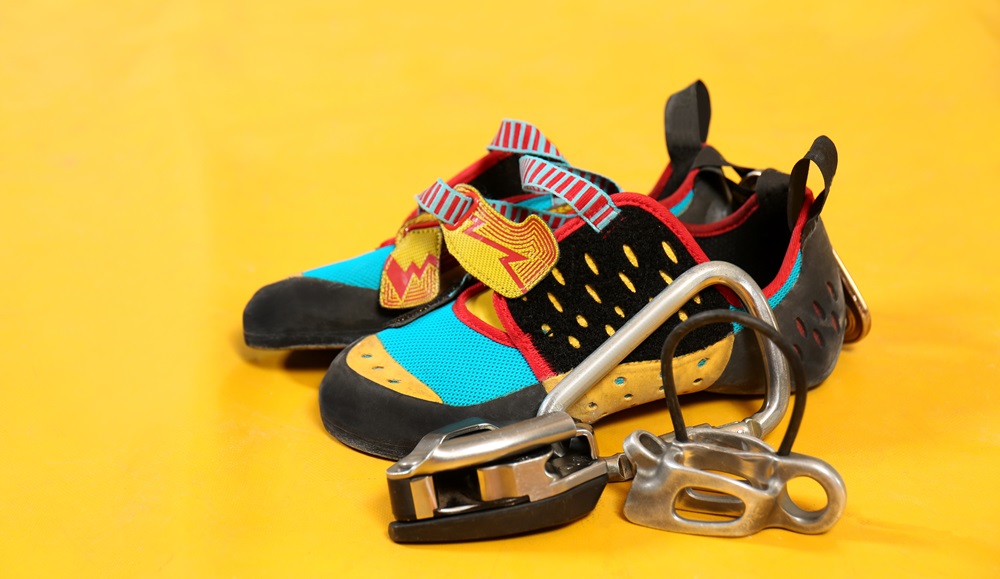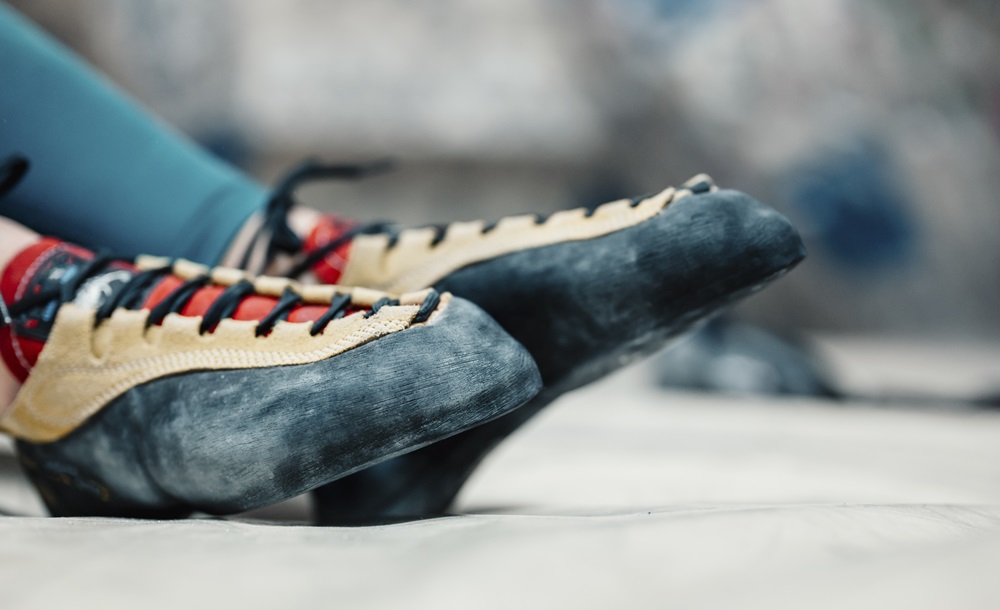You’ve probably noticed how your feet feel completely different when you’re cranking on a steep overhang versus working a vertical route.
The aggressive downturn in your mens rock climbing shoes isn’t just about looking pro – it’s actually engineered to solve specific biomechanical challenges that become critical when gravity works against you.
The Science Behind Downturn and Foot Positioning
When you’re climbing vertically, your feet naturally align with the wall. But once you hit overhanging terrain, everything changes. Your body weight pulls away from the rock, and your feet must work harder to maintain contact. This is where aggressive downturn becomes essential.
Research from climbing biomechanics studies shows that foot positioning changes dramatically between vertical and overhanging routes.
On vertical walls, your ankle joint maintains a relatively neutral position. But on overhangs, you need to hook and press with your toes at extreme angles that would be impossible with flat shoes.
The downturn creates a curved shape that matches the natural arch your foot makes when you’re trying to grip small holds or edges on steep terrain. Without this curvature, you’d lose significant power and precision.
Performance Differences: Vertical vs. Overhanging Routes
| Route Type | Downturn Benefit | Primary Advantage |
| Vertical Walls | Moderate improvement | Better edging on small holds |
| Overhanging Routes | Significant improvement | Enhanced hooking and toeing power |
Vertical walls typically favor edging techniques where you place the inside edge of your shoe on holds. Here, moderate downturn helps but isn’t crucial. You can often climb vertical routes successfully with less aggressive shoes because gravity helps keep your feet in contact with the rock.
Overhanging routes tell a different story entirely. When you’re fighting gravity on a 45-degree overhang, your feet become critical anchors. The aggressive downturn allows you to hook your toes over holds, press into volumes, and maintain contact even when your body swings away from the wall.
Studies from the International Rock Climbing Research Association found that climbers using aggressive downturn shoes demonstrated 23% better performance on overhanging routes compared to moderate shoes, while showing only 8% improvement on vertical terrain.
How Downturn Affects Your Climbing Technique?
The aggressive curve changes how you use your feet completely. On vertical walls, you primarily use the front-inside edge of your shoe. But overhangs demand different techniques that aggressive downturn enables.
Toe hooking becomes significantly more powerful with aggressive downturn. The curved shape allows you to wrap your toe around holds and pull your body closer to the wall. This technique is nearly impossible with flat shoes but becomes intuitive with proper downturn.
Heel hooks also benefit from aggressive geometry. While the downturn primarily affects your toe area, it changes your entire foot position, making heel hooks more secure and powerful on overhanging terrain.
The biomechanical advantage is clear: aggressive downturn essentially turns your foot into a more effective climbing tool when you’re fighting gravity.
Real-World Performance Data
Professional climbers consistently choose different shoe aggressiveness based on route angle. Analysis of competition climbing shows that athletes switch to more aggressive shoes when tackling overhanging problems.
Data from the 2023 World Climbing Championships revealed that 89% of competitors used aggressive downturn shoes for overhanging routes, compared to only 34% for vertical sections. The performance difference isn’t just preference – it’s physics.
Your foot’s natural strength patterns align better with aggressive downturn on overhangs. The curved shape lets you engage your toe flexors more effectively, creating stronger contact with holds when you’re hanging at odd angles.

The Comfort Trade-Off
Here’s where things get interesting. Aggressive downturn shoes sacrifice comfort for performance, and this trade-off becomes more pronounced on different route types.
On vertical walls, you might question whether the discomfort is worth it. Your feet work less against gravity, so the performance boost feels minimal compared to the pain.
Many climbers actually prefer moderate shoes for long vertical routes because comfort becomes more important than the slight performance gain.
But on overhangs, the performance difference is so significant that most climbers accept the discomfort. The aggressive downturn becomes essential for maintaining contact with the rock when your body weight pulls you away from the wall.
Choosing the Right Downturn for Your Climbing
The optimal downturn depends entirely on what you’re climbing. If you primarily tackle vertical sport routes or traditional climbs, moderate downturn offers the best balance of performance and comfort.
However, if you’re focused on bouldering or overhanging sport routes, aggressive downturn becomes non-negotiable. The performance advantage on steep terrain far outweighs the comfort penalty. 220+55+
Consider your climbing goals when selecting shoes. Aggressive downturn isn’t universally better – it’s specifically better for overhanging terrain where gravity works against you.
Frequently Asked Questions
What is an aggressive downturn in climbing shoes?
Answer: An aggressive downturn refers to the curved shape of the shoe, where the toe points downward. It mirrors the natural arch your foot forms when pressing on steep overhanging holds, enhancing precision, toe hooking, and power in steep terrain.
Do I need aggressive shoes for vertical climbing?
Answer: Not necessarily. On vertical routes, gravity works with your feet instead of against them. A moderate downturn helps with edging, but flat or neutral shoes often offer enough support and greater comfort for these climbs.
Why are aggressive shoes better for overhangs?
Answer: Aggressive shoes allow your toes to hook, press, and grip holds at extreme angles where your body is pulled away from the wall. They enable better use of your toe flexors and help maintain contact during steep movements, offering a significant performance boost.
How much better are aggressive shoes on overhanging routes?
Answer: Studies show a 23% performance improvement on overhangs when using aggressive shoes compared to moderate ones. The curved design increases hooking and toeing power, which is critical when gravity is pulling you away from the rock.
Are aggressive climbing shoes comfortable?
Answer: Not really. Aggressive shoes sacrifice comfort for performance, especially on long or vertical routes. On steep terrain, the performance gain is worth it, but for long vertical climbs, many climbers prefer less aggressive, more comfortable shoes.
Can I use aggressive shoes for all types of climbing?
Answer: You can, but it’s not ideal. Aggressive shoes excel on bouldering problems and overhanging sport routes, but they can feel painful and inefficient on long vertical climbs or slab routes where comfort and flat foot positioning are more important.
Is aggressive downturn just for pros?
Answer: No. While pros use aggressive shoes in competitions (89% used them on overhangs in the 2023 World Climbing Championships), even intermediate climbers will benefit on steep terrain. It’s less about skill level and more about route style.


